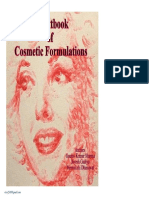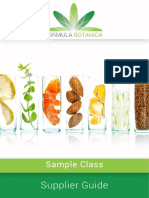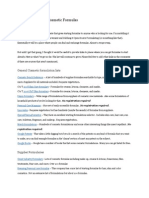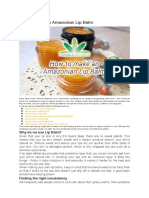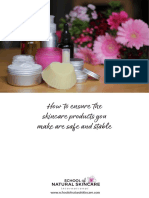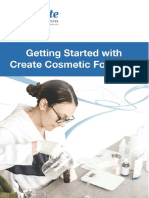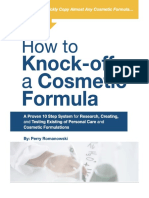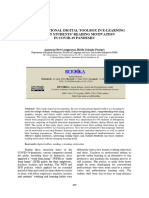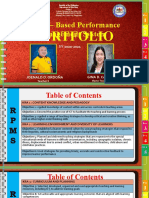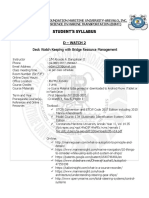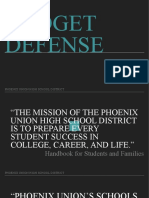Sample Class
Sample Class
Uploaded by
Rakhi PikleCopyright:
Available Formats
Sample Class
Sample Class
Uploaded by
Rakhi PikleOriginal Title
Copyright
Available Formats
Share this document
Did you find this document useful?
Is this content inappropriate?
Copyright:
Available Formats
Sample Class
Sample Class
Uploaded by
Rakhi PikleCopyright:
Available Formats
Welcome to Formula Botanica
Welcome to our Sample Class!
In this short class, we’re going to teach you how to make a simple lip balm. This class
follows the same structure of all of our courses, where you log in to our eLearning
platform and have access to your course materials.
Formula Botanica’s course materials are designed in such a way to help you progress
through your courses at your own pace in your own time. Our study materials contain:
• Professionally filmed videos
• Course notes (such as this document)
• Self-study activities
• Interactive quizzes
• Advanced study projects
• Fun online games
• A cosmetic science glossary
• ‘Ask the tutor’ forums
• Live chats
• A student library filled with bonuses
• Global supplier guide filled with our students’ recommendations
• Access to our online classroom
Your sample class contains one of our professionally designed videos where the
Formula Botanica team will show you how to make a simple natural lip balm. Once you
have watched the video and read through this document, try to make your own lip balm
using our formulation sheet on the final page.
Made your Organic Lip Balm?
Please share photos with us as we’d love to see your creations! We always encourage
our students to share their product photos with us and our wider community, so that we
can all admire their formulations together. We’d love to see your organic lip balms.
Tweet us your formulation images @FormulaBotanica
Share your formulation images on our Facebook page @FormulaBotanica
Tag us in your Instagram images @FormulaBotanica
Use the #FormulaBotanica hashtag
and we’ll share your photo.
2 of 9 Copyright Herb & Hedgerow Ltd. 2016. All Rights Reserved.
Lip Balm: Basic Formulation Information
What is a Lip Balm?
Lips are used in so many different activities – we use them in facial
expressions, when we talk, when we eat, when we drink and when we
kiss. Given how much we use them, it’s important to keep your lips soft
and supple and to keep the skin on your lips healthy.
The skin on your lips is comprised of only 3-5 cellular layers, which is
why your lips can so easily start to bleed if they are chapped or dry, or if
you pick the skin off them. In comparison, the skin on your face
contains up to 16 cellular layers.
Given that your lip skin is only 3-5 layers deep, there are no sweat
glands. This means that your lip skin doesn’t sweat and it doesn’t
produce sebum, your skin’s natural oil. Without sweat and sebum your
lips dry out quicker than other parts of your skin. Dry skin is damaged
quicker, which is why chapped lips are such as a common occurrence.
A lip balm effectively provides that protective layer that you would
normally get from your skin’s natural oils. In covering your lips with an
occlusive layer, it does two things – firstly, it locks moisture in and
secondly, it makes it harder for the heat and cold to dry out your lips.
How do you use it?
Lip balms are applied to prevent the lips from drying out. Your customer
will either want to apply it from a small pot or from a tube.
WARNING! Because we are using essential oils on the skin of the lips
which is incredibly thin, we will only use a 0.1 - 0.5% dilution of
essential oils. Also note that some essential oils can be photosensitising
so should be used sparingly in a product that’s applied so frequently.
Does it need a preservative?
No, this is an anhydrous product that doesn’t come into contact with
water. It won’t need a preservative, although it could benefit from an
antioxidant to prevent the oils and butters from going rancid too quickly.
Antioxidants you could consider are Vitamin E oil or rosemary
oleoresin / extract. We recommend that you are cautious about
Grapefruit Seed Extract as this is often adulterated with synthetic
preservatives.
3 of 9 Copyright Herb & Hedgerow Ltd. 2016. All Rights Reserved.
Lip Balm
Formulation Breakdown
• 20-30% Wax
• 20-30% Butter
• 30-40% Carrier Oil
• 0-10% Botanical Extracts (oil-soluble)
• 0.5-1% Antioxidant
• 0-0.5% Essential Oils
4 of 9 Copyright Herb & Hedgerow Ltd. 2016. All Rights Reserved.
Lip Balm Inspiration + Design Ideas
• Lip balms are great everyday products for keeping the lips in top condition.
Most women, and even some men, carry a lip balm with them everywhere.
Flavoured lip balms are very popular but synthetic flavourings can taste very
artificial and your customers may want to avoid them. When you have a
skincare product that is applied close to your mouth, it is even more important
to ensure that it is 100% safe.
• Lip balms needs to be hard enough to stay on the outer layer of the skin. This
is an example of a product where we don’t want it to penetrate quickly
into the skin. We need it to stay on the skin surface like a barrier, to help protect
the lips from bad weather and moisture loss. To make such a hard balm will
require some form of wax. Beeswax is best but it isn’t vegan, so if you plan to
make vegan skincare you can substitute Candelilla wax for the beeswax.
• You will need to adjust the percentage of wax/butter depending on the climate
you live in. In a cold climate, a high percentage of wax/butter will make your
balms too hard. In a hot climate, you will need a higher percentage of wax/
butter.
• Consider that your lip balm will often be carried around by your customer. They
may carry the lip balm around in their pocket. If you pour your lip balms into
little tubes, you may find that they easily melt when they’re kept warm
constantly. You may need to perform stability tests on your lip balm.
• Allow your lip balms to set hard over a 24 hour period before you determine
whether you’ve got the texture right. Leave it in a hot or warm car for instance
and see how your lip balm feels after a few hours.
• You can design your lip balms to contain natural flavourings such as almond
essence, or vanilla beans macerated in jojoba oil. Make sure that whatever
flavouring you add to your lip balm is oil-soluble otherwise it will not blend with
your other ingredients (which are oil-soluble or lipophilic).
• You can tint your lip balms with natural colourings and oils. There are many
fantastic carrier oils that have a colour which they can impart to your lip balm -
examples include macerated St. John’s Wort oil, macerated carrot oil or
passionfruit oil. You can also incorporate CO2 extracts such as sea buckthorn
CO2 extract to impart a bright yellow colour to your lip balm.
Note that beetroot powder is not oil-soluble so if you want to colour your lip
balms with beetroot, then you will need to emulsify a beetroot glycerite into the
lip balm (a beetroot glycerite is a glycerin-influsion of beetroot powder).
5 of 9 Copyright Herb & Hedgerow Ltd. 2016. All Rights Reserved.
Troubleshooting
1. My balm is too hard:
Try adjusting the wax-butter-oil ratio in the formula. The higher the percentage of oils
you include, the runnier the balm will become. You should also experiment with various
butters as cocoa butter is a hard butter whereas mango is much softer. The ingredients
you choose will affect the hardness of the product.
2. My balm is too soft:
The percentage of wax/fats/oils included in the formula will need to be changed if your
balm is too soft. Remember, adding infused oils / macerates will count as oil in the
overall formulation. You can increase the amount of butter or wax in the formula to make
it slightly harder. Softer balm can also be a problem if you live in a hotter climate as
butters melts easily so please consider this when designing the formula. Remember to
test out your formulations to see how they hold up in different temperatures.
3. My balm is grainy:
Certain soft butters have a tendency to become grainy when they’re heated and cooled
too quickly. Graininess can be an issue even if it isn’t immediately obvious. If this
happens to you, try re-melting the butter and keep on stirring slowly it as it cools.
Graininess most frequently happens in Shea butter or when formulators attempt to
‘shock cool’ their formulations once they’ve been created.
4. My lip balm has a dent in the top of it in the tube:
As your balm cools, it may show a small dent in the top of the tube or even in the jar.
This small dent (as you can see in the image on the front page of this document)
happens because the wax shrinks as it cools. You can either use a hairdryer or heat gun
on the balm to gently re-melt the lip balm in order to create a smooth surface, or you
can add a small amount of extra lip balm on top and then gently melt that.
6 of 9 Copyright Herb & Hedgerow Ltd. 2016. All Rights Reserved.
Sample Lip Balm Formulation
Formula Name: Vitamin E Lip Balm Batch size:
Stage Ingredient Category % gram
1 A Beeswax Foundation 30
2 A Shea Butter Foundation 30
3 A Avocado oil Foundation 28.9
4 A Almond oil Foundation 10
5 B Vitamin E oil Functional - Antioxidant/ Emollient 1
6 B Lavender essential oil Aromaceutical 0.1
10
Total 100
Formulation procedure:
1. Gently melt wax and all ‘Stage A’ ingredients in a bain-marie.
2. When cooler add all ‘Stage B’ ingredients and blend well.
3. Add to a jar or use lip balm tubes and label the finished product.
Notes:
As it contains wax, the mixture will cool quickly. You can modify
this formulation to contain other butters, oils and waxes you might
have. Be careful with the essential oils you choose as some of
them can sensitise your lips to the sun and some of them have
dermal limits, which are regulatory requirements in some parts of
the world. We recommend starting with lavender essential oil.
7 of 9 Copyright Herb & Hedgerow Ltd. 2016. All Rights Reserved.
Study Activity
Create your own version of a lip balm using this formulation worksheet. Get
creative! Study available ingredients to get ideas for new formulation blends.
Research suppliers near to you to see what’s available. Research the botanical
extracts available in your country.
Formula Name: Batch size:
Stage Ingredient Category % gr/ml
10
Formulation procedure:
Notes:
8 of 9 Copyright Herb & Hedgerow Ltd. 2016. All Rights Reserved.
How to Enrol
We hope you enjoyed this sample class. Formula Botanica teaches many different
courses for organic cosmetic formulators. Our courses include:
• Diploma in Organic Skincare Formulation
• Advanced Diploma in Organic Cosmetic Science
• Certificate in Organic Anti-Ageing Skincare
• Certificate in Natural Cosmetic Preservation
• Certificate in Cosmetic Stability Testing
• Certificate in Facial Masque Therapy
• Certificate in Chocolate Spa Products
• Tutor Training Program
We also open enrolment for our flagship International Organic Skincare Entrepreneur
Program twice a year in April and October - enrol for all courses at 30% discount.
Enrolling for a course is easy
Follow these 3 simple steps to enrol today:
1. Visit http://www.formulabotanica.com and choose the course best suited to your
interests and experience. If you are new to formulating, then we recommend
starting with our Diploma in Organic Skincare Formulation.
2. Add the course or program you want to enrol for to your shopping cart and go
through checkout / enrolment.
3. You will then immediately receive all of your enrolment information, your student
welcome pack and your login details. Make sure you check your junkmail folder or
Promotions Tab in Gmail.
9 of 9 Copyright Herb & Hedgerow Ltd. 2016. All Rights Reserved.
You might also like
- Cosmetic Formulation Fundamentals Masterclass BookletDocument55 pagesCosmetic Formulation Fundamentals Masterclass BookletDian Neviana100% (10)
- Im Not A Chemist But I Love Formulating1Document26 pagesIm Not A Chemist But I Love Formulating1Kavina Rolle100% (4)
- Formulations of Cosmetics and Personal CareDocument15 pagesFormulations of Cosmetics and Personal CareKingson_78685% (20)
- Natural Beauty Recipe Book School of Natural SkincareDocument47 pagesNatural Beauty Recipe Book School of Natural Skincarefaniy iolabi91% (11)
- 30DaysToBecomeABetterCosmeticChemist PDFDocument218 pages30DaysToBecomeABetterCosmeticChemist PDFDubravka Anicic100% (17)
- Handbook of Practical FormulatingDocument105 pagesHandbook of Practical FormulatingKaterina Karadik100% (17)
- Guide To Cosmetic FormulationsDocument99 pagesGuide To Cosmetic Formulationskashif25100% (2)
- Making Natural Products - Complete GuideDocument307 pagesMaking Natural Products - Complete Guidemolesag97% (76)
- A Book of Cosmetics FormulationDocument95 pagesA Book of Cosmetics FormulationSudimar Adi Nugroho93% (15)
- Basic Notes On: Glycerin Extracts (Glycerites)Document9 pagesBasic Notes On: Glycerin Extracts (Glycerites)Dr. Ghulam Fareed75% (4)
- Organic Shampoos Made Easy: 50 DIY Sulfate-Free Natural Homemade Shampoos And Hair Care Recipes For Beautiful HairFrom EverandOrganic Shampoos Made Easy: 50 DIY Sulfate-Free Natural Homemade Shampoos And Hair Care Recipes For Beautiful HairRating: 5 out of 5 stars5/5 (3)
- Formula Botanica Ingredients ClassificationDocument1 pageFormula Botanica Ingredients ClassificationKarina67% (3)
- Ultimate: Formulation Cheat Sheet: by Cosmetic Science AcademyDocument4 pagesUltimate: Formulation Cheat Sheet: by Cosmetic Science AcademyKira100% (5)
- Supplier Guide (Sample Version)Document3 pagesSupplier Guide (Sample Version)Subash D100% (1)
- Where To Find Free Cosmetic Formulas 10.08.2012Document14 pagesWhere To Find Free Cosmetic Formulas 10.08.2012Pakistan-cosmetics Manufacturers100% (2)
- Formulation EmollientDocument6 pagesFormulation EmollientIin Nasya Haris100% (1)
- Natarajan MGMT 5320-3BDocument14 pagesNatarajan MGMT 5320-3BKarthik SivaramakrishnanNo ratings yet
- Tp-Technical Drafting NC IiDocument6 pagesTp-Technical Drafting NC IiCris VidalNo ratings yet
- Module 6 Creams and Lotions v3Document20 pagesModule 6 Creams and Lotions v3jesse100% (4)
- Natural Emulsifiers and Preservative Factsheet FINALDocument8 pagesNatural Emulsifiers and Preservative Factsheet FINALFrederick HeisenbergNo ratings yet
- Amazonian Lip BalmDocument3 pagesAmazonian Lip BalmGabriela OliveiraNo ratings yet
- Safe and Stable Cosmetic Checklist School of Natural SkincareDocument17 pagesSafe and Stable Cosmetic Checklist School of Natural SkincareAri100% (6)
- Getting Started With Create Cosmetic FormulasDocument25 pagesGetting Started With Create Cosmetic FormulasZEMOURA100% (2)
- Cream Lotion Slip BalmsDocument31 pagesCream Lotion Slip BalmsHanifah Fitriani100% (4)
- 4 of 4. Making Mineral&coloured MakeupDocument21 pages4 of 4. Making Mineral&coloured MakeupIrisPrima100% (3)
- Bodycare Types of Products and IngredientsDocument5 pagesBodycare Types of Products and Ingredientssandapeharda9717No ratings yet
- My Buttered Life Personal Care Edition FinalDocument18 pagesMy Buttered Life Personal Care Edition Finalxiuhtlati100% (3)
- LC-Lip BalmDocument10 pagesLC-Lip BalmShruti JainNo ratings yet
- Organic Lotions Made Easy: 50 DIY Natural Homemade Lotion Recipes For A Beautiful And Glowing SkinFrom EverandOrganic Lotions Made Easy: 50 DIY Natural Homemade Lotion Recipes For A Beautiful And Glowing SkinRating: 5 out of 5 stars5/5 (3)
- Natural Soap: Techniques and Recipes for Beautiful Handcrafted Soaps, Lotions and BalmsFrom EverandNatural Soap: Techniques and Recipes for Beautiful Handcrafted Soaps, Lotions and BalmsRating: 4.5 out of 5 stars4.5/5 (2)
- Easy Lotion Recipes: Natural and Budget-Friendly Recipes to Revitalize Your Skin!: DIY Beauty ProductsFrom EverandEasy Lotion Recipes: Natural and Budget-Friendly Recipes to Revitalize Your Skin!: DIY Beauty ProductsNo ratings yet
- Natural & Organic Beauty Recipes - A Complete Guide on Making Your Own Facial Masks, Toners, Lotions, Moisturizers, & Scrubs at Home with Simple & Easy Organic Skin Care RecipesFrom EverandNatural & Organic Beauty Recipes - A Complete Guide on Making Your Own Facial Masks, Toners, Lotions, Moisturizers, & Scrubs at Home with Simple & Easy Organic Skin Care RecipesRating: 3 out of 5 stars3/5 (4)
- Organic Body Cream Made Easy: Homemade Beauty Recipes For A Moisturized, Flawless And Nourished SkinFrom EverandOrganic Body Cream Made Easy: Homemade Beauty Recipes For A Moisturized, Flawless And Nourished SkinNo ratings yet
- Simple Homemade Lotion: Easy Homemade Beauty Products For A Silky Soft, Gorgeous And Radiant Looking Skin!From EverandSimple Homemade Lotion: Easy Homemade Beauty Products For A Silky Soft, Gorgeous And Radiant Looking Skin!No ratings yet
- Body Butter Basics: Learning to make your own Body Lotions and Butters for Happier Healthier SkinFrom EverandBody Butter Basics: Learning to make your own Body Lotions and Butters for Happier Healthier SkinRating: 4 out of 5 stars4/5 (1)
- Bath and Body Luxuries : Recipes for Pampering Yourself and OthersFrom EverandBath and Body Luxuries : Recipes for Pampering Yourself and OthersRating: 5 out of 5 stars5/5 (1)
- Bath Bombs Easy Beginners Recipes: Easy Beginners Recipes To Unlock The Therapeutic Power Of Bath Bombs For Better HealthFrom EverandBath Bombs Easy Beginners Recipes: Easy Beginners Recipes To Unlock The Therapeutic Power Of Bath Bombs For Better HealthRating: 5 out of 5 stars5/5 (3)
- Prospectus Diploma in Natural Skincare FormulationDocument67 pagesProspectus Diploma in Natural Skincare FormulationKopal Agarwal100% (1)
- Bonus Infused OilsDocument4 pagesBonus Infused OilsSubash D100% (2)
- Share HOW TO FORMULAT-WPS OfficeDocument15 pagesShare HOW TO FORMULAT-WPS OfficeMoosub KhanNo ratings yet
- FormulaBotanicaFactSheet ChoosingRightEmulsifierFINALDocument3 pagesFormulaBotanicaFactSheet ChoosingRightEmulsifierFINALOlga Rodrigues0% (1)
- BSB Recipes 0319 PDFDocument26 pagesBSB Recipes 0319 PDFJay Parte100% (6)
- KnockoffDocument30 pagesKnockoffKira100% (3)
- Formula+Botanica+School+Prospectus 5Document53 pagesFormula+Botanica+School+Prospectus 5Syahadah Rizka Anefi100% (2)
- Formula Botanica School Prospectus 2019-2020Document54 pagesFormula Botanica School Prospectus 2019-2020Mayada Ahmad100% (4)
- Shampoo Recipes: Phase ADocument40 pagesShampoo Recipes: Phase Atony_lopez_3100% (2)
- Ingredients Directory (Sample Version)Document8 pagesIngredients Directory (Sample Version)Shraddha KrishnaNo ratings yet
- Cream Formulation and StabilityDocument17 pagesCream Formulation and StabilityKho Siong Thong100% (2)
- Distance Learning in Cosmetic ScienceDocument10 pagesDistance Learning in Cosmetic Sciencemike.constantin188% (8)
- Taking Care of Your Formulations - 2003Document43 pagesTaking Care of Your Formulations - 2003microbiologist125100% (4)
- A Unique Formulation of A Cosmetics PerparationDocument20 pagesA Unique Formulation of A Cosmetics PerparationRinta MoonNo ratings yet
- Formulation Classes and Raw Materials2Document123 pagesFormulation Classes and Raw Materials2Musicalhouses Ofaf86% (7)
- Organic Skincare E-BookDocument100 pagesOrganic Skincare E-BookChukwu Janefrances86% (7)
- Creams/Moisturizers Cleansers/Scrubs 4 Miscellaneous 4 Supplier Listing 6Document7 pagesCreams/Moisturizers Cleansers/Scrubs 4 Miscellaneous 4 Supplier Listing 6adrianNo ratings yet
- AMT Formulation Guide v2 PDFDocument44 pagesAMT Formulation Guide v2 PDFrenatoporanga100% (7)
- Body Melt or Lotion BarDocument2 pagesBody Melt or Lotion BarGabriela OliveiraNo ratings yet
- 5 Natural CosmeticsDocument18 pages5 Natural CosmeticsicraoNo ratings yet
- Basic Cosmetics Manufacturing 1st EditionDocument26 pagesBasic Cosmetics Manufacturing 1st EditionPakistan-cosmetics Manufacturers100% (7)
- Make Your Own Cooling Rhassoul Clay HairDocument3 pagesMake Your Own Cooling Rhassoul Clay HairMariana Pinheiro0% (1)
- 28 Waxes Used in Cosmetics PDFDocument1 page28 Waxes Used in Cosmetics PDFMahmud Murtofa Salekin100% (1)
- Recipe Booklet CompressedDocument32 pagesRecipe Booklet Compressedxiuhtlati100% (9)
- Kra #Master TeachersDocument29 pagesKra #Master TeachersMary Joy Catrina AnduyonNo ratings yet
- Springboard Homework HelpDocument5 pagesSpringboard Homework Helpafnaxdxtloexll100% (1)
- 1 PBDocument9 pages1 PBjokitugasoke24No ratings yet
- Results - Based Performance Management System: PortfolioDocument57 pagesResults - Based Performance Management System: PortfolioJoenald Kent OrdoñaNo ratings yet
- What Is Communication TechnologyDocument4 pagesWhat Is Communication Technologygeetkumar18100% (1)
- Serious Games As New Educational Tools: How Effective Are They? A Meta-Analysis of Recent StudiesDocument13 pagesSerious Games As New Educational Tools: How Effective Are They? A Meta-Analysis of Recent StudiesCamiloNo ratings yet
- Owl Craft Lesson PlanDocument4 pagesOwl Craft Lesson Planapi-357307525No ratings yet
- Handout-Teacher's - Staff Handbook 2019-20Document75 pagesHandout-Teacher's - Staff Handbook 2019-20syed babar khan babar khanNo ratings yet
- Student'S Syllabus: Deck Watch Keeping With Bridge Resource ManagementDocument18 pagesStudent'S Syllabus: Deck Watch Keeping With Bridge Resource Managementloween john seloterioNo ratings yet
- Patel, Pritesh - BTA3O1-2 - Course Outline - Semester 2 - 2022-2023Document4 pagesPatel, Pritesh - BTA3O1-2 - Course Outline - Semester 2 - 2022-2023Innocent OkekeNo ratings yet
- Role of E Learning in National DevelopmentDocument9 pagesRole of E Learning in National DevelopmentAymenAhmadNo ratings yet
- Enriching The Teaching of Basic Swimming Strokes in Aquatics Utilizing Contextualized Video Demonstration: An Action ResearchDocument13 pagesEnriching The Teaching of Basic Swimming Strokes in Aquatics Utilizing Contextualized Video Demonstration: An Action ResearchPsychology and Education: A Multidisciplinary JournalNo ratings yet
- Microsoft Word - Biology - Genetics UnitDocument20 pagesMicrosoft Word - Biology - Genetics Unitapi-233894872No ratings yet
- Research FinalDocument32 pagesResearch FinalRod Bryant PatricioNo ratings yet
- Best Practice: How To Implement Two-Panel SelectorsDocument4 pagesBest Practice: How To Implement Two-Panel SelectorsAlaa SallamNo ratings yet
- Douglas FrankishDocument2 pagesDouglas Frankishdfrankish7No ratings yet
- Course For BotanyDocument26 pagesCourse For BotanymrmalikwaqaswaseemNo ratings yet
- Ead 510 - Budget DefenseDocument15 pagesEad 510 - Budget Defenseapi-578761151No ratings yet
- Analyzing The Practicality of The Lifelong Learning Policy in PakistanDocument10 pagesAnalyzing The Practicality of The Lifelong Learning Policy in PakistanArooj Ahmed100% (2)
- Customer Service & Soft Sales: Princess CruisesDocument8 pagesCustomer Service & Soft Sales: Princess CruisesEthan WNo ratings yet
- Read The Text and Answer The Questions. MemorandumDocument8 pagesRead The Text and Answer The Questions. Memorandumadriana VelazcoNo ratings yet
- Intensive Review: SituationDocument10 pagesIntensive Review: SituationJolly Anne Foronda ArcegaNo ratings yet
- DLL For Dressmaking 8Document8 pagesDLL For Dressmaking 8Fritzie Beligolo Modillas100% (4)
- ENGG 420 SYLLABUS - XLSX - SyllabusDocument18 pagesENGG 420 SYLLABUS - XLSX - Syllabusperezclarence64No ratings yet
- Home Ec 7-8Document24 pagesHome Ec 7-8meryllNo ratings yet
- Holy Trinity University Integrated Basic Education DepartmentDocument59 pagesHoly Trinity University Integrated Basic Education DepartmentSusie P. LaguismaNo ratings yet
- MARK956 Subject Outline T1 2024 31 JanDocument22 pagesMARK956 Subject Outline T1 2024 31 JanMustafa ChawdharyNo ratings yet
- Lesson Plan - 7 - 8 Week 5Document1 pageLesson Plan - 7 - 8 Week 5mohamed Darwish (ICT HOD)No ratings yet









